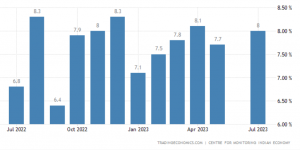
India has been witnessing a consistent surge in self-employment. According to the latest data from CMIE, the proportion of self-employed individuals stood at 83.8% during the January-April period, a significant increase from 55% during the same period in 2016, a time when the entrepreneurs category was dominated by businessmen and qualified professionals. The composition of entrepreneurs, as tracked by CMIE since 2016, has undergone a drastic transformation. This shift is driven by a decline in the number of businessmen and a simultaneous rise in the count of self-employed entrepreneurs.
The upward trajectory of self-employment in India can be attributed to several factors, including the impact of the coronavirus pandemic and the government’s emphasis on self-reliance, as evident in the ‘Atmanirbhar Bharat’ initiative. The declining number of businessmen and prosperous entrepreneurs, despite a growing population, in contrast to the noticeable upswing in self-employment, is indicative of unfavourable economic conditions. CMIE suggests that this employment trend shift does not signify a surge in genuine entrepreneurship; rather, it mirrors the scarcity of satisfactory job opportunities within the economy. The prevalence of self-employment among most workers can be attributed to a lack of alternatives.
READ | Insurance Law (Amendment) Bill 2023: Industry must wait longer for its game changer
Self-employed individuals pertain to entrepreneurs running their own business ventures, but these enterprises tend to lack significant financial capital, human capital, or specialised skills. This category encompasses taxi drivers, beauticians, real estate agents, brokers, insurance agents, models, astrologers, and similar professions. On the contrary, businessmen are individuals establishing substantial businesses that necessitate capital and a workforce for operation. They operate from fixed locations like offices, shops, workshops, or factories.
Globally, employment opportunities contracted amidst and post the COVID-19 pandemic, as numerous companies, both large and small, downsized their workforce to mitigate costs. A few months before the pandemic hit, the government had suggested youth to generate income by selling pakoras rather than remaining unemployed. Interestingly, this advice seems to have resonated with people, potentially influencing them to seek alternative employment avenues outside traditional governmental jobs.
India unemployment rate

Issues with self-employment
While self-employment stands as a preferable option over unemployment, it is burdened by a range of challenges for those within this entrepreneurial category. The IZA World of Labor highlights that a significant proportion of the world’s impoverished population are self-employed, indicative of insufficient opportunities in most developing nations for these individuals to escape poverty despite their hard work. This underscores the fact that despite their efforts, many within this group continue to grapple with poverty. Policymakers need to discern these issues and work toward enhancing returns from self-employment, while simultaneously facilitating transitions toward higher-paying wage-based employment opportunities.
Moreover, establishing appropriate policies becomes imperative not only to bolster the earnings of the self-employed but also to bridge the benefits gap typically enjoyed by traditional employees, such as health insurance and retirement plans. Policymakers must also acknowledge that self-employment offers limited rewards due to the associated risks and uncertainties, including the absence of guaranteed income.
Taking an overview of employment in India, data from the Centre for Monitoring Indian Economy reveals that total employment between January and April 2023 reached 412.9 million, marking an increase of 8.6 million compared to the pre-pandemic period of January-April 2019. This working population is categorised into four main segments: business, salaried, small traders and wage laborers, and farmers.
The majority of India’s working population remains engaged in farming, wage labour, or small trade. The salaried class forms the next largest group, followed by the business class. Notably, among these four categories, only the number of individuals classified as part of the business class has shown an upward trend in comparison to the pre-pandemic levels. Over the past four years, the business category has grown by 8.4 million individuals, whereas the remaining segments are yet to recover to their pre-pandemic figures.
Similar to any aspiring global powerhouse, India requires a rising number of entrepreneurs, as the private sector actively contributes to an economy when promising opportunities arise. However, a favourable business sentiment will only emerge if India’s economy generates appropriate incentives for private sector engagement. Entrepreneurs hold the potential to serve as vital engines of economic growth, but the proportion of entrepreneurs plays a pivotal role in delineating the trajectory of this growth.
